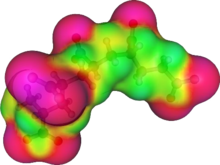COSMO (chemistry)

COSMO (short for " Co nductor-like s creening mo del") is a method for calculating the electrostatic interaction of a molecule with a solvent .
Basics
At COSMO, the solvent is treated as a continuum based on a dielectric constant ε and other parameters (volume of the molecules, atomic radius , ...) . The method therefore belongs to the class of continuum solvation models . It is also assumed that the solvent extends to the “interface” of the dissolved molecule. This interface is set as the envelope of spheres around the individual atoms ( van der Waals radius of the atoms plus a fixed distance for the solvent molecules). For the actual calculation, this area is made up of flat sections , e.g. B. triangles, approximated.
If the solvent were an ideal conductor , the electrical potential on this surface would have to disappear; from this, if the distribution of the charges in the molecule is known, the charge q * on the surface could easily be determined.
For real solvents it can be roughly assumed that the charge q is less than the charge q * by a factor f :
This factor f is approximate
The summand 0.5 in the denominator is an empirically found quantity.
The energy of the interaction between the dissolved molecule and the solvent can then be determined from the charges q of the solvent determined in this way and the known charge distribution of the molecule .
application
The COSMO method can be used for all calculation methods in theoretical chemistry in which the charge distribution of a molecule can be determined, for example semiempirical calculations , Hartree-Fock calculations or density functional theory calculations.
Comparison with other methods
While models based on multipole expansion of the charge distribution of a molecule are restricted to small or approximately spherical or ellipsoidal molecules, the COSMO method has the advantage that it can also be used for large and irregularly shaped molecular structures .
The higher the dielectric constant of the solvent, the more precise the COSMO method, because in the limit case of an infinitely high dielectric constant the liquid behaves like an ideal conductor; with water (ε ≈ 80) a very good accuracy is achieved. For solvents with a low dielectric constant, a complete solution of the electrostatic equations would be more precise, but would involve more effort.
In contrast to molecular dynamics calculations, in which the movement of the solvent molecules is calculated and their position and density are averaged over a period of time, the COSMO model, like all continuum models, has the advantage of significantly lower computational effort . However, it is fundamentally not able to correctly describe phenomena that are related to the granularity of the solvent.
Individual evidence
- ^ A. Klamt, G. Schüürmann: "COSMO: A New Approach to Dielectric Screening in Solvents with Explicit. Expressions for the Screening Energy and its Gradient ", in: J. Chem. Soc., Perkin Trans. 2 , 1993 , pp. 799-805; doi : 10.1039 / P29930000799 .


